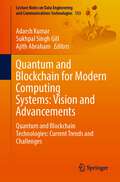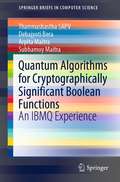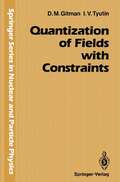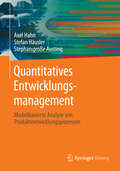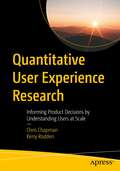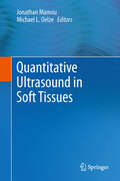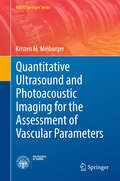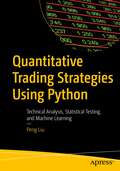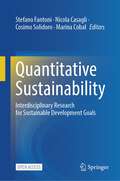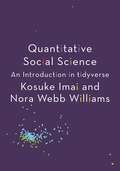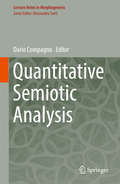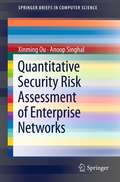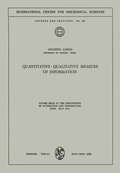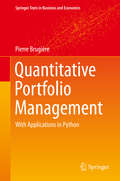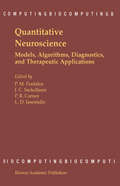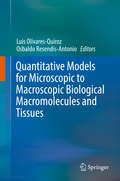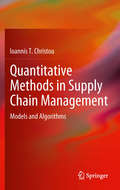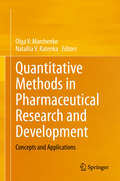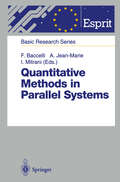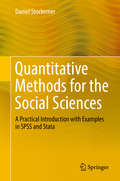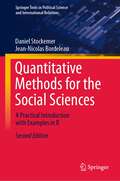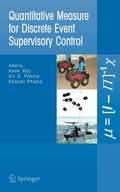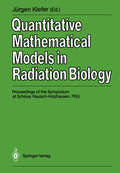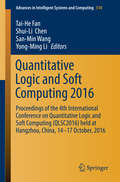- Table View
- List View
Quantum and Blockchain for Modern Computing Systems: Quantum and Blockchain Technologies: Current Trends and Challenges (Lecture Notes on Data Engineering and Communications Technologies #133)
by Adarsh Kumar Sukhpal Singh Gill Ajith AbrahamThis book states that blockchain technology provides a secure distributed, peer-to-peer, and decentralized network with advanced cryptography primitives and protocols. The important question that arises in the quantum computing world is to test the existing blockchain networks against quantum attacks and design quantum computing enabled secure blockchain solutions. This book encourages professionals from different fields to provide blockchain and quantum technology-integrated solutions that incorporate low-cost, effective QoS, fast, secure, and futuristic demands. This book has surveyed and proposed approaches that improve quantum computing and cryptography protocols. Quantum computing and quantum science are not just helpful in software but the hardware world as well. To design networks with quantum science, quantum-enabled devices like quantum memories and quantum repeaters can be useful to demonstrate for organizations. For example, designing a single quantum repeater for long-distance quantum communication is useful in reducing the network cost, and ensuring better security levels. This book has introduced the quantum computing and blockchain technology aspects, their integration approaches and future directions.
Quantum Algorithms for Cryptographically Significant Boolean Functions: An IBMQ Experience (SpringerBriefs in Computer Science)
by Tharrmashastha SAPV Debajyoti Bera Arpita Maitra Subhamoy MaitraThis book is a timely report of the state-of-the-art analytical techniques in the domain of quantum algorithms related to Boolean functions. It bridges the gap between recent developments in the area and the hands-on analysis of the spectral properties of Boolean functions from a cryptologic viewpoint. Topics covered in the book include Qubit, Deutsch–Jozsa and Walsh spectrum, Grover’s algorithm, Simon’s algorithm and autocorrelation spectrum. The book aims at encouraging readers to design and implement practical algorithms related to Boolean functions. Apart from combinatorial techniques, this book considers implementing related programs in a quantum computer. Researchers, practitioners and educators will find this book valuable.
Quantized Phenomena of Transport and Magneto-Optics in Magnetic Topological Insulator Heterostructures (Springer Theses)
by Masataka MogiThis book presents experimental studies on emergent transport and magneto-optical properties in three-dimensional topological insulators with two-dimensional Dirac fermions on their surfaces. Designing magnetic heterostructures utilizing a cutting-edge growth technique (molecular beam epitaxy) stabilizes and manifests new quantization phenomena, as confirmed by low-temperature electrical transport and time-domain terahertz magneto-optical measurements. Starting with a review of the theoretical background and recent experimental advances in topological insulators in terms of a novel magneto-electric coupling, the author subsequently explores their magnetic quantum properties and reveals topological phase transitions between quantum anomalous Hall insulator and trivial insulator phases; a new topological phase (the axion insulator); and a half-integer quantum Hall state associated with the quantum parity anomaly. Furthermore, the author shows how these quantum phases can be significantly stabilized via magnetic modulation doping and proximity coupling with a normal ferromagnetic insulator. These findings provide a basis for future technologies such as ultra-low energy consumption electronic devices and fault-tolerant topological quantum computers.
Quantization of Fields with Constraints (Springer Series in Nuclear and Particle Physics)
by Dmitri Gitman Igor V. TyutinGauge field theories underlie all models now used in elementary particle physics. These theories refer to the class of singular theories which are also theories with constraints. The quantization of singular theories remains one of the key problems of quantum field theory and is being intensively discussed in the literature. This book is an attempt to fill the need for a comprehensive analysis of this problem, which has not heretofore been met by the available monographs and reviews. The main topics are canonical quantization and the path integral method. In addition, the Lagrangian BRST quantization is completely described, for the first time in a monograph. The book also presents a number of original results obtained by the authors, in particular, a complete description of the physical sector of an arbitrary gauge theory, quantization of singular theories with higher theories with time-dependent constraints, and correct derivatives, quantization of canonical quantization of theories of a relativistic point-like particle. As a general illustration we present quantization of field theories such as electrodynamics, Yang-Mills theory, and gravity. It should be noted that this monograph is aimed not only at giving the reader the rules of quantization according to the principle "if you do it this way, it will be good", but also at presenting strong arguments based on the modem interpretation of the classical and quantum theories which show that these methods· are the natural, if not the only possible ones.
Quantitatives Entwicklungsmanagement: Modellbasierte Analyse von Produktentwicklungsprozessen
by Axel Hahn Stefan Häusler Stephan große AustingDie Produktentwicklung ist der dynamischste und am schwersten zu beherrschende Prozess in Industrieunternehmen. Prozessreifegradmodelle wie CMMI erfordern dazu quantitative Methoden als Werkzeug des Entwicklungsmanagements.Mit der modellgetriebenen Entwicklung steht eine Datenbasis für eine durchgehende quantitative Analyse zur Verfügung. Modellanalysen erlauben eine prozessbegleitende Qualitätsmessung und die Bestimmung der Produktkomplexität und des Entwicklungsfortschritts. Das Buch stellt bestehende Methoden des quantitativen Entwicklungsmanagements zur Entscheidungsunterstützung auf operativer und strategischer Ebene vor. Die Autoren zeigen, wie die modellgetriebene Entwicklung zur Analyse der erreichten Ergebnisse genutzt werden kann, etwa zur Bewertung von Methoden, Werkzeugen sowie zur Prozess- oder Projektanpassung.
Quantitative User Experience Research: Informing Product Decisions by Understanding Users at Scale
by Chris Chapman Kerry RoddenThis book is your definitive guide to the rapidly growing role of Quantitative User Experience (Quant UX) Research in product development. The book provides an overview of the skills you need on the job, presents hands-on projects with reusable code, and shares advice on starting and developing a career. The book goes beyond basic skills to focus on what is unique to Quant UX. The authors are two of the most widely recognized practitioners in Quant UX research, and this book shares insights from their combined decades of experience. Organizations today have more data about user needs and behaviors than ever before. With this large-scale data, Quant UX researchers work to understand usage patterns, measure the impact of design changes, and inform strategic decisions. In the Quant UX role, interdisciplinary researchers apply analytical skills to uncover user needs, inform engineering and design, answer strategic business questions, and optimize software and hardware products for human interaction. This book provides guidance around customer satisfaction surveys, understanding user behavior from log analysis, and the statistical methods that are commonly used to assess user outcomes. What You Will LearnDiscover the role of Quantitative User Experience (Quant UX) researchUnderstand how Quant UX research differs from other disciplines such as data sciencePlan common research projects and know how to achieve successPosition Quant UX activities in product development, engineering, and UX organizationsApply the HEART framework to measure user experience outcomesEvaluate your skills and potential to be hired as a Quant UX researcherKnow what to expect during job interviewsFind examples of common Quant UX projects with shared R code and data setsWho This Book Is ForPractitioners and managers who seek a comprehensive guide to the new field of Quantitative User Experience Research. Readers will understand the Quant UX role, build research skills, find examples of hands-on code and analyses, learn about UX organizations and stakeholders, and receive advice on job interviews and career paths. Data scientists, social scientists, and other researchers will learn how their skills transfer to Quant UX, where they can help teams build better, more successful products.
Quantitative Ultrasound in Soft Tissues
by Jonathan Mamou and Michael L. OelzeDue to parallel advances in signal processing and computer hardware in the last 15 years, quantitative ultrasound techniques have reached maturity, allowing for the construction of quantitative maps or images of soft tissues. This book will focus on 5 modern research topics related to quantitative ultrasound of soft tissues: - Spectral-based methods for tissue characterization, tissue typing, cancer detection, etc.; - Envelope statistics analysis as a means of quantifying and imaging tissue properties; - Ultrasound elastography for quantifying elastic properties of tissues (several clinical ultrasound scanners now display elastography images); - Scanning acoustic microscopy for forming images of mechanical properties of soft tissues with micron resolution (desktop size scanners are now available); and - Ultrasound computer tomography for breast cancer imaging (new ultrasound tomography systems have been developed and are currently under evaluation clinically).
Quantitative Ultrasound and Photoacoustic Imaging for the Assessment of Vascular Parameters (PoliTO Springer Series)
by Kristen M. MeiburgerThis book describes the development of quantitative techniques for ultrasound and photoacoustic imaging in the assessment of architectural and vascular parameters. It presents morphological vascular research based on the development of quantitative imaging techniques for the use of clinical B-mode ultrasound images, and preclinical architectural vascular investigations on quantitative imaging techniques for ultrasounds and photoacoustics.The book is divided into two main parts, the first of which focuses on the development and validation of quantitative techniques for the assessment of vascular morphological parameters that can be extracted from B-mode ultrasound longitudinal images of the common carotid artery. In turn, the second part highlights quantitative imaging techniques for assessing the architectural parameters of vasculature that can be extracted from 3D volumes, using both contrast-enhanced ultrasound (CEUS) imaging and photoacoustic imaging without the addition of any contrast agent. Sharing and summarizing the outcomes of this important research, the book will be of interest to a broad range of researchers and practitioners in the fields of medical imaging and biomedical engineering.
Quantitative Trading Strategies Using Python: Technical Analysis, Statistical Testing, and Machine Learning
by Peng LiuBuild and implement trading strategies using Python. This book will introduce you to the fundamental concepts of quantitative trading and shows how to use Python and popular libraries to build trading models and strategies from scratch. It covers practical trading strategies coupled with step-by-step implementations that touch upon a wide range of topics, including data analysis and visualization, algorithmic trading, backtesting, risk management, optimization, and machine learning, all coupled with practical examples in Python.Part one of Quantitative Trading Strategies with Python covers the fundamentals of trading strategies, including an introduction to quantitative trading, the electronic market, risk and return, and forward and futures contracts. Part two introduces common trading strategies, including trend-following, momentum trading, and evaluation process via backtesting. Part three covers more advanced topics, including statistical arbitrage using hypothesis testing, optimizing trading parameters using Bayesian optimization, and generating trading signals using a machine learning approach. Whether you're an experienced trader looking to automate your trading strategies or a beginner interested in learning quantitative trading, this book will be a valuable resource. Written in a clear and concise style that makes complex topics easy to understand, and chock full of examples and exercises to help reinforce the key concepts, you’ll come away from it with a firm understanding of core trading strategies and how to use Python to implement them.What You Will LearnMaster the fundamental concepts of quantitative tradingUse Python and its popular libraries to build trading models and strategies from scratchPerform data analysis and visualization, algorithmic trading, backtesting, risk management, optimization, and machine learning for trading strategies using PythonUtilize common trading strategies such as trend-following, momentum trading, and pairs tradingEvaluate different quantitative trading strategies by applying the relevant performance measures and statistics in a scientific manner during backtestingWho This Book Is ForAspiring quantitative traders and analysts, data scientists interested in finance, and researchers or students studying quantitative finance, financial engineering, or related fields.
Quantitative Sustainability: Interdisciplinary Research for Sustainable Development Goals
by Stefano Fantoni Nicola Casagli Cosimo Solidoro Marina CobalThis open access book focuses on how scientific methodologies can help industrial managers, entrepreneurs and policymakers handle the 17 Sustainable Development Goals in an efficient and realistic way. It also offers an operative scheme for scientists to overcome their discipline barriers. Is interdisciplinarity an intrinsic research value or is it merely instrumental for handling the increasing flux of open problems that sustainability poses to science?Can these problems of sustainability be solved with what the authors already know? Is it just a matter of having the right people at the table and giving them sufficient resources, or is it something more? Is meeting the needs of the present without compromising those of future generations a scientific definition of sustainable development? Questions similar to those posed in the sixties regarding complexity must be asked about sustainability today. In addition, the new data science includes powerful tools for making novel quantitative predictions about future sustainability indicators, an open problem that the book discusses. This book is primarily addressed to Ph.D. students, postdocs and senior researchers in the Life and Hard Science (LHS) and Social Sciences and Humanities (SSH) disciplines, as well as professionals of the primary, secondary and tertiary industrial sectors.
Quantitative Social Science: An Introduction in tidyverse
by Kosuke Imai Nora Webb WilliamsA tidyverse edition of the acclaimed textbook on data analysis and statistics for the social sciences and allied fieldsQuantitative analysis is an essential skill for social science research, yet students in the social sciences and related areas typically receive little training in it. Quantitative Social Science is a practical introduction to data analysis and statistics written especially for undergraduates and beginning graduate students in the social sciences and allied fields, including business, economics, education, political science, psychology, sociology, public policy, and data science. Proven in classrooms around the world, this one-of-a-kind textbook engages directly with empirical analysis, showing students how to analyze and interpret data using the tidyverse family of R packages. Data sets taken directly from leading quantitative social science research illustrate how to use data analysis to answer important questions about society and human behavior.Emphasizes hands-on learning, not paper-and-pencil statisticsIncludes data sets from actual research for students to test their skills onCovers data analysis concepts such as causality, measurement, and prediction, as well as probability and statistical toolsFeatures a wealth of supplementary exercises, including additional data analysis exercises and programming exercisesOffers a solid foundation for further studyComes with additional course materials online, including notes, sample code, exercises and problem sets with solutions, and lecture slides
Quantitative Semiotic Analysis (Lecture Notes in Morphogenesis)
by Dario CompagnoThis contributed volume gives access to semiotic researches adopting a quantitative stance. European semiotics is traditionally based on immanent methodologies: meaning is seen as an autonomous dimension of human existence, whose laws can be investigated via purely qualitative analytical and reflexive analysis. Today, researches crossing disciplinary boundaries reveal the limitations of such an homogeneous practice. In particular, two families of quantitative research strategies can be identified. On the one hand, researchers wish to naturalize meaning, by making semiotic results interact with those coming from Neurophysiological and psychological sciences. On the other hand, statistical and computational tools are adopted to work on linguistic and multimedia corpora. The book acts to put the two approaches into dialogue.
Quantitative Security Risk Assessment of Enterprise Networks (SpringerBriefs in Computer Science)
by Xinming Ou Anoop SinghalProtection of enterprise networks from malicious intrusions is critical to the economy and security of our nation. This article gives an overview of the techniques and challenges for security risk analysis of enterprise networks. A standard model for security analysis will enable us to answer questions such as “are we more secure than yesterday” or “how does the security of one network configuration compare with another one”. In this article, we will present a methodology for quantitative security risk analysis that is based on the model of attack graphs and the Common Vulnerability Scoring System (CVSS). Our techniques analyze all attack paths through a network, for an attacker to reach certain goal(s).
Quantitative-Qualitative Measure of Information: Course held at the Department of Automation and Information, June - July 1972 (CISM International Centre for Mechanical Sciences #138)
by Guiseppe LongoQuantitative Portfolio Management: with Applications in Python (Springer Texts in Business and Economics)
by Pierre BrugièreThis self-contained book presents the main techniques of quantitative portfolio management and associated statistical methods in a very didactic and structured way, in a minimum number of pages. The concepts of investment portfolios, self-financing portfolios and absence of arbitrage opportunities are extensively used and enable the translation of all the mathematical concepts in an easily interpretable way. All the results, tested with Python programs, are demonstrated rigorously, often using geometric approaches for optimization problems and intrinsic approaches for statistical methods, leading to unusually short and elegant proofs. The statistical methods concern both parametric and non-parametric estimators and, to estimate the factors of a model, principal component analysis is explained. The presented Python code and web scraping techniques also make it possible to test the presented concepts on market data. This book will be useful for teaching Masters students and for professionals in asset management, and will be of interest to academics who want to explore a field in which they are not specialists. The ideal pre-requisites consist of undergraduate probability and statistics and a familiarity with linear algebra and matrix manipulation. Those who want to run the code will have to install Python on their pc, or alternatively can use Google Colab on the cloud. Professionals will need to have a quantitative background, being either portfolio managers or risk managers, or potentially quants wanting to double check their understanding of the subject.
Quantitative Neuroscience: Models, Algorithms, Diagnostics, and Therapeutic Applications (Biocomputing #2)
by Panos M. Pardalos J. Chris Sackellares Paul R. Carney Leon D. IasemidisAdvances in the field of signal processing, nonlinear dynamics, statistics, and optimization theory, combined with marked improvement in instrumenta tion and development of computers systems, have made it possible to apply the power of mathematics to the task of understanding the human brain. This verita ble revolution already has resulted in widespread availability of high resolution neuroimaging devices in clinical as well as research settings. Breakthroughs in functional imaging are not far behind. Mathematical tech niques developed for the study of complex nonlinear systems and chaos already are being used to explore the complex nonlinear dynamics of human brain phys iology. Global optimization is being applied to data mining expeditions in an effort to find knowledge in the vast amount of information being generated by neuroimaging and neurophysiological investigations. These breakthroughs in the ability to obtain, store and analyze large datasets offer, for the first time, exciting opportunities to explore the mechanisms underlying normal brain func tion as well as the affects of diseases such as epilepsy, sleep disorders, movement disorders, and cognitive disorders that affect millions of people every year. Ap plication of these powerful tools to the study of the human brain requires, by necessity, collaboration among scientists, engineers, neurobiologists and clini cians. Each discipline brings to the table unique knowledge, unique approaches to problem solving, and a unique language.
Quantitative Models for Microscopic to Macroscopic Biological Macromolecules and Tissues
by Luis Olivares-Quiroz Osbaldo Resendis-AntonioThis book presents cutting-edge research on the use of physical and mathematical formalisms to model and quantitatively analyze biological phenomena ranging from microscopic to macroscopic systems. The systems discussed in this compilation cover protein folding pathways, gene regulation in prostate cancer, quorum sensing in bacteria to mathematical and physical descriptions to analyze anomalous diffusion in patchy environments and the physical mechanisms that drive active motion in large sets of particles, both fundamental descriptions that can be applied to different phenomena in biology. All chapters are written by well-known experts on their respective research fields with a vast amount of scientific discussion and references in order the interested reader can pursue a further reading. Given these features, we consider Quantitative Models for Microscopic to Macroscopic Biological Macromolecules and Tissues as an excellent and up-to-date resource and reference for advanced undergraduate students, graduate students and junior researchers interested in the latest developments at the intersection of physics, mathematics, molecular biology, and computational sciences. Such research field, without hesitation, is one of the most interesting, challenging and active of this century and the next.
Quantitative Methods in Supply Chain Management: Models and Algorithms
by Ioannis T. ChristouQuantitative Methods in Supply Chain Management presents some of the most important methods and tools available for modeling and solving problems arising in the context of supply chain management. In the context of this book, “solving problems” usually means designing efficient algorithms for obtaining high-quality solutions.The first chapter is an extensive optimization review covering continuous unconstrained and constrained linear and nonlinear optimization algorithms, as well as dynamic programming and discrete optimization exact methods and heuristics. The second chapter presents time-series forecasting methods together with prediction market techniques for demand forecasting of new products and services. The third chapter details models and algorithms for planning and scheduling with an emphasis on production planning and personnel scheduling. The fourth chapter presents deterministic and stochastic models for inventory control with a detailed analysis on periodic review systems and algorithmic development for optimal control of such systems. The fifth chapter discusses models and algorithms for location/allocation problems arising in supply chain management, and transportation problems arising in distribution management in particular, such as the vehicle routing problem and others. The sixth and final chapter presents a short list of new trends in supply chain management with a discussion of the related challenges that each new trend might bring along in the immediate to near future. Overall, Quantitative Methods in Supply Chain Management may be of particular interest to students and researchers in the fields of supply chain management, operations management, operations research, industrial engineering, and computer science.
Quantitative Methods in Pharmaceutical Research and Development: Concepts and Applications
by Olga V. Marchenko Natallia V. KatenkaThis contributed volume presents an overview of concepts, methods, and applications used in several quantitative areas of drug research, development, and marketing. Chapters bring together the theories and applications of various disciplines, allowing readers to learn more about quantitative fields, and to better recognize the differences between them. Because it provides a thorough overview, this will serve as a self-contained resource for readers interested in the pharmaceutical industry, and the quantitative methods that serve as its foundation. Specific disciplines covered include:BiostatisticsPharmacometricsGenomicsBioinformaticsPharmacoepidemiologyCommercial analyticsOperational analyticsQuantitative Methods in Pharmaceutical Research and Development is ideal for undergraduate students interested in learning about real-world applications of quantitative methods, and the potential career options open to them. It will also be of interest to experts working in these areas.
Quantitative Methods in Parallel Systems (ESPRIT Basic Research Series)
by Francois Baccelli Alain Jean-Marie Isi MitraniIt is widely recognized that the complexity of parallel and distributed systems is such that proper tools must be employed during their design stage in order to achieve the quantitative goals for which they are intended. This volume collects recent research results obtained within the Basic Research Action Qmips, which bears on the quantitative analysis of parallel and distributed architectures. Part 1 is devoted to research on the usage of general formalisms stemming from theoretical computer science in quantitative performance modeling of parallel systems. It contains research papers on process algebras, on Petri nets, and on queueing networks. The contributions in Part 2 are concerned with solution techniques. This part is expected to allow the reader to identify among the general formalisms of Part I, those that are amenable to an efficient mathematical treatment in the perspective of quantitative information. The common theme of Part 3 is the application of the analytical results of Part 2 to the performance evaluation and optimization of parallel and distributed systems. Part 1. Stochastic Process Algebras are used by N. Gotz, H. Hermanns, U. Herzog, V. Mertsiotakis and M. Rettelbach as a novel approach for the struc tured design and analysis of both the functional behaviour and performability (i.e performance and dependability) characteristics of parallel and distributed systems. This is achieved by integrating stochastic modeling and analysis into the powerful and well investigated formal description techniques of process algebras.
Quantitative Methods for the Social Sciences: A Practical Introduction With Examples In Spss And Stata
by Daniel StockemerThis textbook offers an essential introduction to survey research and quantitative methods. Building on the premise that statistical methods need to be learned in a practical fashion, the book guides students through the various steps of the survey research process and helps to apply those steps toward a real example. In detail, the textbook introduces students to the four pillars of survey research and quantitative analysis: (1) the importance of survey research, (2) preparing a survey, (3) conducting a survey and (4) analyzing a survey. Students are shown how to create their own questionnaire based on some theoretically derived hypotheses to achieve empirical findings for a solid dataset. Lastly, they use said data to test their hypotheses in a bivariate and multivariate realm. The book explains the theory, rationale and mathematical foundations of these tests. In addition, it provides clear instructions on how to conduct the tests in SPSS and Stata. Given the breadth of its coverage, the textbook is suitable for introductory statistics, survey research or quantitative methods classes in the social sciences.
Quantitative Methods for the Social Sciences: A Practical Introduction with Examples in R (Springer Texts in Political Science and International Relations)
by Daniel Stockemer Jean-Nicolas BordeleauThis textbook offers an essential introduction to survey research and quantitative methods with clear instructions on how to conduct statistical tests with R. Building on the premise that we need to teach statistical methods in a holistic and practical format, the book guides students through the four main elements of survey research and quantitative analysis: (1) the importance of survey research, (2) preparing a survey, (3) conducting a survey and (4) analyzing a survey. In detail, students will learn how to create their own questionnaire on the basis of formulating hypotheses; sampling participants; disseminating their questionnaire; creating datasets; and analyzing their data. The data analytical sections of this revised and extended edition explain the theory, rationale and mathematical foundations of relevant bivariate and multi-variate statistical tests. These include the T-test, F-test, Chi-square test and correlation analyses, as well as bivariate and multivariate regression analyses. In addition, the book offers a brief introduction to statistical computing with R, which includes clear instructions on how to conduct these statistical tests in R. Given the breadth of its coverage, the textbook is suitable for introductory statistics, survey research and quantitative methods classes in the social sciences.
Quantitative Measure for Discrete Event Supervisory Control
by Asok Ray Vir V. Phoha Shashi PhohaSupervisory Control Theory (SCT) provides a tool to model and control human-engineered complex systems, such as computer networks, World Wide Web, identification and spread of malicious executables, and command, control, communication, and information systems. Although there are some excellent monographs and books on SCT to control and diagnose discrete-event systems, there is a need for a research monograph that provides a coherent quantitative treatment of SCT theory for decision and control of complex systems. This new monograph will assimilate many new concepts that have been recently reported or are in the process of being reported in open literature. The major objectives here are to present a) a quantitative approach, supported by a formal theory, for discrete-event decision and control of human-engineered complex systems; and b) a set of applications to emerging technological areas such as control of software systems, malicious executables, and complex engineering systems. The monograph will provide the necessary background materials in automata theory and languages for supervisory control. It will introduce a new paradigm of language measure to quantitatively compare the performance of different automata models of a physical system. A novel feature of this approach is to generate discrete-event robust optimal decision and control algorithms for both military and commercial systems.
Quantitative Mathematical Models in Radiation Biology: Proceedings of the Symposium at Schloss Rauisch-Holzhausen, FRG, July 1987
by Jürgen KieferRadiation is the one agent among all environmental factors which may damage biological systems that is not only easily quantifiable but can also be measured with unsurpassed resolution. Its primary effects on atoms and molecules are well understood, and the secondary processes can be followed by sophisticated experimental techniques. The quantum nature of interactions and the importance of stochastic variations call for an exact mathematical description. This task is by no means simple, and presents a challenge both to the experimentalist and to the theoretician. It is hoped that a generally acceptable formalism will help to quantify radiation responses, both in radiation protection and radiation therapy, and make it possible to move from a purely empirical approach with all its fallacies to real understanding.
Quantitative Logic and Soft Computing 2016: Proceedings of the 4th International Conference on Quantitative Logic and Soft Computing (QLSC2016) held at Hangzhou, China, 14-17 October, 2016 (Advances in Intelligent Systems and Computing #510)
by Tai-He Fan Shui-Li Chen San-Min Wang Yong-Ming LiThis book is the proceedings of the Fourth International Conference on Quantitative Logic and Soft Computing (QLSC2016) held 14-17, October, 2016 in Zhejiang Sci-Tech University, Hangzhou, China. It includes 61 papers, of which 5 are plenary talks( 3 abstracts and 2 full length talks). QLSC2016 was the fourth in a series of conferences on Quantitative Logic and Soft Computing. This conference was a major symposium for scientists, engineers and practitioners to present their updated results, ideas, developments and applications in all areas of quantitative logic and soft computing. The book aims to strengthen relations between industry research laboratories and universities in fields such as quantitative logic and soft computing worldwide as follows: (1) Quantitative Logic and Uncertainty Logic; (2) Automata and Quantification of Software; (3) Fuzzy Connectives and Fuzzy Reasoning; (4) Fuzzy Logical Algebras; (5) Artificial Intelligence and Soft Computing; (6) Fuzzy Sets Theory and Applications.
